Chapter 18.23
TC TOWN CENTER ZONE DISTRICT
Sections:
18.23.015 Applicability of design standards.
18.23.030 Development standards – General.
18.23.040 Design standards – General.
18.23.050 Development and design standards – Specific to properties fronting main streets.
18.23.060 Park and open space.
18.23.010 Intent.
The intent of the town center (TC) zone district is to create a mixed use, urban density, transit-supported town center. The area should consist of multistory buildings oriented to create convenient pedestrian and transit access. Use of public gathering areas, shared parking facilities and public walkways that connect uses within the town center are envisioned. Development should occur in a manner that is consistent with the goals and policies set forth in the Tumwater comprehensive plan. The town center zone district consists of the following subdistricts (Figure 18.23.010):
A. Town Center Mixed Use. The intent of the town center mixed use subdistrict is to provide mixed retail, office and residential uses at a level of intensity sufficient to support transit services and to provide a focus for the town center. Mixed use can include: development of a parcel or structure with one or more different land uses, such as a combination of residential, office, retail, public, or entertainment in a single or physically integrated group of structures. A broad mix of land uses are allowed in this subdistrict, including retail, personal and professional services, restaurants, entertainment, lodging, community facilities and residential. Along designated main streets (Figure 18.23.010), ground floor retail sales, personal services and restaurants are encouraged with residential uses, professional services and general offices on the upper stories.
B. Town Center Professional Office. The intent of the town center professional office subdistrict is to provide for employment growth in government, professional, business, health and personal services. Complementary retail sales within an office structure are allowed.
C. Town Center Civic. The intent of the town center civic subdistrict is to provide for civic uses that provide identity and focus for the Tumwater town center.
D. Town Center Residential. The intent of the town center residential subdistrict is to provide for a high quality, high density living environment within walking distance of jobs, shopping and public transportation. A mix of housing choices is encouraged to create a variety in residential opportunities.
The intent of the design standards in this chapter is:
A. To design buildings to promote an architecturally appealing environment. Design emphasis should be given to the pedestrian through the provision of structural and facade elements that encourage pedestrian activity and maximize the infusion of natural light.
B. To design parking structures to blend with adjacent developments. Emphasize attractive design features that minimize the obtrusiveness of the parking use and encourage architectural compatibility with adjacent development. Structures should be well lighted and create a feeling of openness and safety.
C. To encourage design elements that convey the historical theme of Tumwater. Pitched or mansard metal roofs, decorative brick facades, and ornamental towers with pitched roofs and decorative cornices are examples of design elements that reflect the history of Tumwater. Several of these elements are incorporated into the designs of civic and commercial buildings along Israel Road, including Tumwater City Hall, Tumwater Headquarters Fire Station and the Tumwater Timberland Library.
D. To create streets that provide a sense of enclosure, activity, safety and interest, and are attractive to pedestrians.
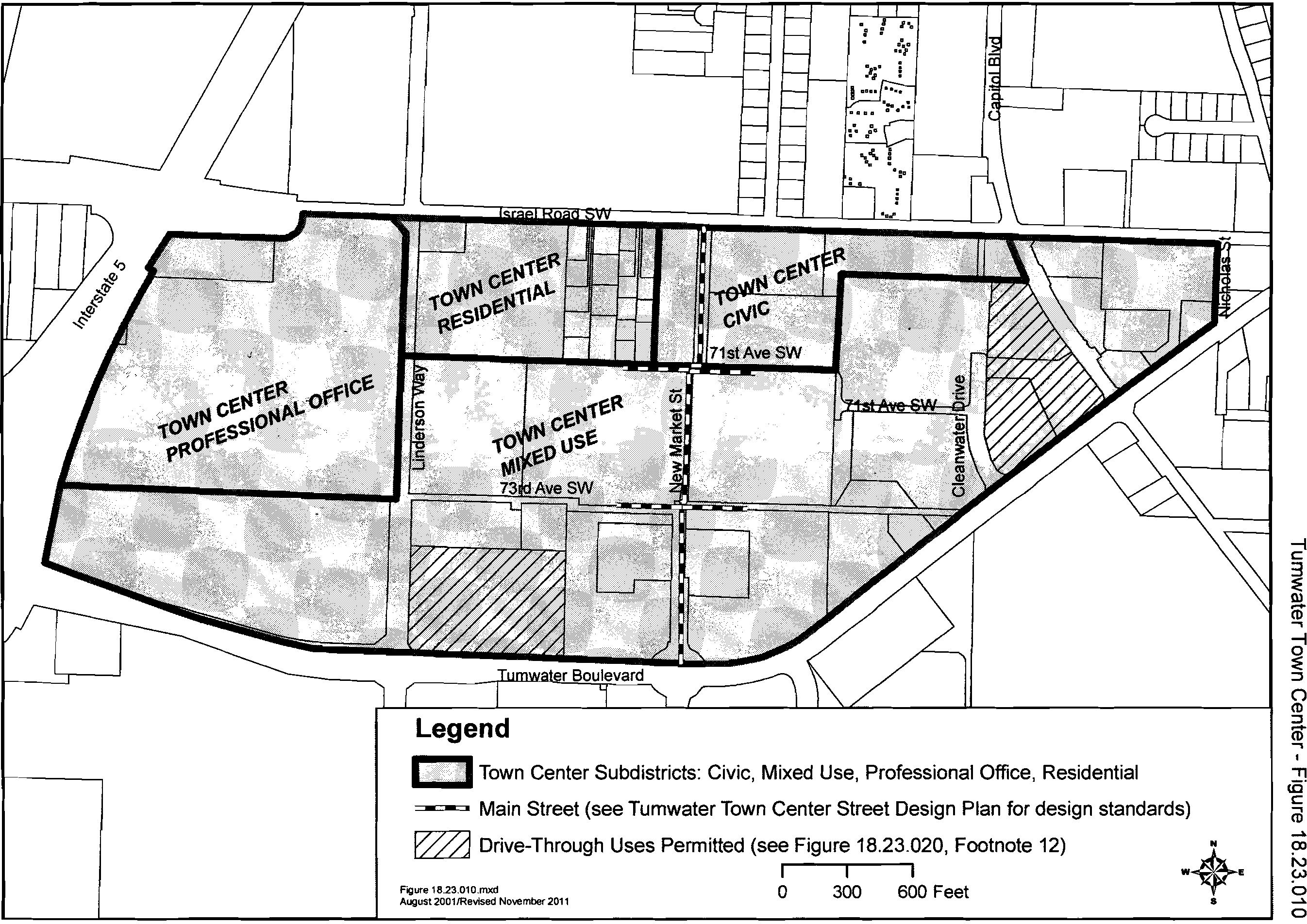
(Ord. O2011-006, Amended, 11/15/2011; Ord. O2006-034; Amended, 07/17/2007; Ord. O2002-019, Amended, 01/07/2002; Ord. O2001-020, Added, 05/07/2002)
18.23.015 Applicability of design standards.
A. The design standards in TMC 18.23.040 and 18.23.050 apply to:
1. Any new building or parking structure or expansion of an existing building or parking structure that amounts to or exceeds either four thousand square feet or twenty-five percent of the assessed valuation of the existing building or parking structure within any thirty-six-month period; provided, that these standards shall not apply to single-family dwellings, duplexes and accessory uses associated with single-family dwellings and duplexes; and
2. Exterior remodels or alterations to all buildings and parking structures except for single-family dwellings, duplexes and accessory uses associated with single-family dwellings and duplexes. Only the portions of the building or site being altered or added to shall be required to comply with the design standards. Even if otherwise applying, these standards do not apply to remodels or alterations that do not change the exterior appearance of the building or parking structure.
B. These design standards supplement requirements described in other sections of this chapter. Where these design standards conflict with other requirements contained in TMC Title 18 (Zoning), Tumwater development standards or the International Building Code (IBC) or its successor, those requirements shall apply, except that these design standards shall supersede design review guidelines in TMC Chapter 18.43 where conflicts may occur.
C. Standards may include options and illustrations of methods in which the intent of the standard can be achieved. The options provided are not intended to be all inclusive and other equal or better design techniques, as approved by the community development director, may be used to satisfy the design standard.
(Ord. O2011-002, Amended, 03/01/2011; Ord. O2002-019, Added, 01/07/2003)
18.23.020 Uses.
Land uses allowed for each subdistrict are listed in Figure 18.23.020. Permitted uses are identified with a “P,” conditional uses with a “C,” and accessory uses with an “A.”
|
LAND USES |
TOWN CENTER ZONE SUBDISTRICTS |
|||
|---|---|---|---|---|
|
Town Center Mixed Use |
Town Center Professional Office |
Town Center Residential |
Town Center Civic |
|
|
Accessory wireless communication antennas |
A1 |
A1 |
A1 |
A1 |
|
Adult family homes, residential care facilities |
P |
|
P |
|
|
Attached wireless communication facilities |
P1 |
P1 |
P1 |
P1 |
|
Automobile service station legally established prior to June 9, 2002 |
C2 |
|
|
|
|
Breweries, wineries, distilleries |
P |
|
|
|
|
Centers for senior citizens, youth, general community and similar groups |
P |
P |
|
P |
|
Child day care center; child mini-day care center |
P |
P |
P |
P |
|
Churches |
C |
|
C |
|
|
Civic center complex |
P |
|
|
P |
|
Community center |
P |
P |
|
P |
|
Community gardens |
P |
P |
P |
P |
|
Distribution, fabrication, and assembly facilities occurring within buildings lawfully constructed on Port of Olympia property on or before January 1, 2000 |
C4 |
|
|
|
|
Drive-through uses |
P12 |
|
|
|
|
Electric vehicle infrastructure |
P |
P |
P |
P |
|
Emergency communication antennas (essential public facility) |
C1, 5 |
C1, 5 |
C1, 5 |
C1, 5 |
|
Emergency housing |
P15, A16 |
|
A16 |
|
|
Emergency shelter |
P15, A16 |
|
A16 |
|
|
Entertainment facilities |
P6 |
|
|
|
|
Family child care homes |
P |
|
P |
|
|
Farmers markets |
P |
P |
P |
P |
|
Food truck or trailer courts |
P13 |
P13 |
|
P13 |
|
Food trucks or trailers |
P14 |
P14 |
|
P14 |
|
Group foster homes |
P |
P |
P |
P |
|
Home occupations |
A |
|
A |
|
|
Library, museum, art gallery |
P |
|
|
P |
|
Medical clinics |
P |
P |
|
|
|
Mixed use commercial/residential developments |
P |
|
|
|
|
Motels, hotels |
P |
|
|
|
|
Movie theaters, playhouses and similar performance and assembly facilities |
P |
|
|
P |
|
Noncommercial recreational structures including but not limited to swimming pools and recreational ball courts |
|
|
A |
|
|
Offices |
P |
P |
|
P |
|
Optometry clinics |
P |
P |
|
P |
|
Parking lots |
A7 |
A |
A |
A |
|
Parking structures |
P8 |
P |
P |
P |
|
Parks and open space areas |
P |
P |
P |
P |
|
Permanent supportive housing |
P15, A16 |
|
P15, A16 |
|
|
Personal services |
P |
P |
|
P |
|
Planned unit development (see TMC Chapter 18.36) |
P |
P |
P |
P |
|
Post offices |
P |
P |
|
P |
|
Preschool childcare facilities |
A |
A |
A |
A |
|
Private clubs and lodges |
P |
P |
C |
|
|
Professional services |
P |
P |
|
P |
|
Recreational facilities |
P |
P |
P |
P |
|
Residential uses approved after June 9, 2002, provided the minimum density standards in TMC 18.23.030(B)(2) are met |
|
|
P |
|
|
Residential uses which were legally established prior to June 9, 2002 |
|
|
P |
|
|
Restaurants |
P |
A9 |
A10 |
|
|
Retail sales |
P |
A |
A10 |
|
|
Roominghouses |
A |
|
|
|
|
Schools |
P |
|
|
|
|
Senior housing facilities, independent and assisted |
P |
|
P |
|
|
State education facilities (essential public facility) |
C |
|
|
|
|
Storage sheds, tool sheds, greenhouses, carports |
|
|
A |
|
|
Support facilities |
P11 |
P11 |
P11 |
P11 |
|
Taverns, cocktail lounges |
P3 |
|
|
|
|
Temporary expansions of schools, such as portable classrooms |
P |
|
|
|
|
Transitional housing |
P15, A16 |
|
P15, A16 |
|
|
Transportation terminals |
C |
C |
|
|
Figure 18.23.020 Footnotes:
(1) Emergency communication antennas and wireless communication facilities are subject to Federal Aviation Administration (FAA) standards and approval, and furthermore both uses are subject to provisions for wireless communication facilities in TMC Chapter 11.20, Wireless Communication Facilities.
(2) Any alteration to the site or building that requires a conditional use permit shall meet the minimum conditions provided in TMC Chapter 18.56. An application for a conditional use permit shall be processed pursuant to TMC Title 14, Development Code Administration, and TMC Chapter 2.58, Hearing Examiner.
(3) Cocktail lounges are also permitted as accessory uses within restaurants.
(4) The cumulative amount of future expansions shall not exceed fifty percent of the covered floor space existing on January 1, 2000, for each site. See TMC Chapter 18.56.
(5) Antennas must be affixed to or erected upon existing buildings, water tanks or other existing structures. Antennas shall not be affixed to a wireless communication support structure. Emergency communication towers are not permitted.
(6) Motorized go-cart facilities are not permitted.
(7) See TMC 18.23.040(F) for surface parking lot siting requirements on properties fronting main streets.
(8) In the Town Center Mixed Use subdistrict, a parking structure may be located along a main street, provided the portion of the first floor fronting the main street is designed to accommodate a use allowed by this chapter other than parking.
(9) Restaurants may be allowed as accessory uses within a general or professional office building in the Town Center Professional Office subdistrict.
(10) Restaurants and retail sales are allowed as accessory uses in the Town Center Residential subdistrict when located on the first floor of a multistory residential building, provided the gross floor area dedicated to restaurant and/or retail sales use shall not exceed one thousand five hundred square feet per building or twenty-five percent of the first floor of each building, whichever is greater, and provided the residential portion of the development meets the density standards described in TMC 18.23.030.
(11) Electrical switching substations, electrical power transmission towers, natural gas pipelines, natural gas gate stations and regulating stations, and park and ride facilities are not permitted.
(12) Drive-through uses for espresso stands less than five hundred square feet in floor area, pharmacies, and banks and credit unions are allowed in the areas specified on Figure 18.23.010. Properties with drive-through uses in the Town Center zone district shall not have direct vehicular access onto either Capitol Boulevard or Tumwater Boulevard. The director may allow temporary vehicular access to Capitol Boulevard in order to accommodate changes to the street grid. Drive-through uses shall also meet the drive-through design guidelines of TMC Chapter 18.43. Where conflicts occur between this chapter and TMC Chapter 18.43, the more restrictive requirement shall apply.
(13) Food truck or trailer courts are subject to the requirements of TMC 18.42.120.
(14) Food trucks or trailers are subject to the requirements of TMC 18.42.120.
(15) Supportive housing facilities such as emergency housing, emergency shelters, permanent supportive housing, and transitional housing are subject to the requirements of TMC 18.42.150.
(16) Supportive housing facilities such as emergency housing, emergency shelters, permanent supportive housing, and transitional housing are permitted as an accessory use only as part of a permitted church use. Such supportive housing facilities shall not exceed twenty percent of the total building square footage of a church use and are subject to the requirements of TMC 18.42.150.
Figure 18.23.020 Explanatory Note:
1. If the box is shaded, the use is not allowed in that zone district.
(Ord. O2022-013, Amended, 10/04/2022; Ord. O2021-019, Amended, 01/18/2022; Ord. O2020-005, Amended, 03/16/2021; Ord. O2019-020, Amended, 11/19/2019; Ord. O2019-007, Amended, 09/03/2019; Ord. O2018-025, Amended, 12/18/2018; Ord. O2017-019, Amended, 12/05/2017; Ord. O2017-006, Amended, 07/18/2017; Ord. O2016-006, Amended, 06/07/2016; Ord. O2013-025, Amended, 01/07/2014; Ord. O2011-006, Amended, 11/15/2011; Ord. O2010-029, Amended, 06/07/2011; Ord. O2010-015, Amended, 09/07/2010; Ord. O2006-034, Amended, 07/17/2007; Ord. O2001-020, Added, 05/07/2002)
18.23.030 Development standards – General.
A. Airspace Surfaces. A series of imaginary airspace surfaces surround the Olympia Regional Airport. Except as necessary and incidental to airport operations, no structure or tree shall penetrate airspace surfaces as defined by 14 C.F.R. Part 77. See Figure 18.23.030A for additional information regarding airspace surfaces. The purpose of Figure 18.23.030A is to provide a visual description of airspace surfaces and may not be relied upon as determinative of the extent to which a structure may penetrate an airspace surface. A map that provides sufficient detailed information on ground and imaginary airspace surface elevations to be determinative is available for inspection in the community development department.
Nothing in this chapter shall diminish the responsibility of project proponents to submit a Notice of Construction or Alteration to the Federal Aviation Administration if required in accordance with Subpart B of Federal Aviation Regulations Part 77, “Objects Affecting Navigable Airspace.”
B. Densities.
1. Town Center Mixed Use Subdistrict.
a. Minimum floor area ratio: none.
b. Maximum floor area ratio (FAR): 2.0 or a total of two square feet of gross floor area per one square foot of site area. The maximum FAR applies to the gross floor area of all buildings on the site, excluding parking structures and residential dwelling units. The community development director may administratively allow the FAR to be increased up to 3.0 if fifty percent of the additional FAR is for retail use.
2. Town Center Residential Subdistrict.
a. Minimum density: thirty dwelling units per acre.
b. Maximum density: none.
c. Density Calculation. Calculation of density is based on the portion of the site devoted to residential and associated uses (e.g., dwelling units; private community clubs, open space; stormwater detention, treatment and infiltration). The following land is excluded from density calculations:
i. Land that is required to be dedicated for public use as open space, right-of-way, or land on which development is prohibited by TMC Title 16, Environment, and land that is to be used for private roads. Provided, that portion of open space/park areas that consists of stormwater facilities and that is designed for active and/or passive recreational purposes in accordance with the drainage design and erosion control manual for Tumwater shall not be excluded from density calculations.
ii. Land that consists of lots devoted to uses other than residential and associated uses, including but not limited to churches, schools, and support facilities (except for stormwater detention, treatment and infiltration facilities).
C. Structure height: see Figure 18.23.030.
D. Setbacks. Minimum setbacks from property lines are provided in Figure 18.23.030. A maximum setback as described in TMC 18.23.050 applies to developments in the town center mixed use subdistrict with frontage on main streets identified in Figure 18.23.010.
E. Lot Coverage. No maximum, except adequate space must be provided for required parking, yards, landscaping and open space.
F. Open Storage. Open storage is prohibited. Long-term parking of operational company cars, light trucks, and vans within parking lots shall not be construed to be open storage.
G. Signs. Requirements of TMC Chapter 18.44 shall be met.
H. Off-Street Parking. Requirements of TMC Chapter 18.50 shall be met.
I. Fencing and Landscaping. Requirements of TMC Chapters 18.46 and 18.47 shall be met.
J. Design Review Guidelines. Requirements of TMC Chapter 18.43 shall be met; provided, that the design standards in this chapter shall supersede design guidelines in TMC Chapter 18.43 where conflicts may occur.
K. Pedestrian Access.
1. An on-site pedestrian circulation system that links the street and the primary entrance(s) of the structure(s) shall be provided. Sidewalks or pedestrian ways must connect the required pedestrian system to existing pedestrian systems on adjacent developments if adequate safety and security can be maintained. Convenient pedestrian access to transit stops shall be provided.
2. Sidewalks, walkways or pedestrian systems shall be required and constructed according to the city of Tumwater development guide.
3. Where the pedestrian circulation system crosses driveways, parking areas, and loading areas, it must be clearly identifiable, through the use of elevation changes, speed bumps, or a different paving material as approved by the community development director.
4. Lighting for parking lots and pedestrian ways shall be provided to ensure personal safety. Such lighting shall be integrated into the architectural character both in terms of illumination and fixtures. Lighting for parking lots shall meet the requirements of TMC 18.50.060(K). Lighting for pedestrian ways shall be shielded and be directed downward and inward or other techniques may be utilized to minimize impacts on off-site uses.
|
Subdistrict |
Height |
Front Setback5 |
Side Setback5 |
Rear Setback5 |
|---|---|---|---|---|
|
Town Center Mixed Use |
65 Feet1,6 |
0 Feet2 |
0 Feet4 |
0 Feet4 |
|
Town Center Professional Office |
100 Feet1 |
0 Feet |
0 Feet4 |
0 Feet4 |
|
Town Center Residential |
55 Feet1,7 |
0 Feet |
0 Feet5 |
0 Feet5 |
|
Town Center Civic |
65 Feet1 |
0 Feet |
0 Feet4 |
0 Feet4 |
Figure 18.23.030 Notes:
(1) See subsection A of this section for additional height restrictions.
(2) See TMC 18.23.050(A) for the maximum setback requirement for properties with frontage on main streets.
(3) See TMC 18.04.230 for setback diagram.
(4) Where any structures or portions of structures within the town center mixed use, professional office or civic subdistrict, containing any permitted, accessory and/or conditional use allowed by this chapter, are adjacent to the town center residential subdistrict, the minimum setback shall be ten feet and shall be screened in accordance with TMC Chapter 18.47.
(5) Where any structures or portions of structures within the residential subdistrict, containing any permitted, accessory and/or conditional use allowed by this chapter, are adjacent to the town center mixed use, professional office or civic subdistrict, the minimum setback shall be five feet and shall be screened in accordance with TMC Chapter 18.47.
(6) The maximum structure height of sixty-five feet in the town center mixed use subdistrict may be increased to eighty-five feet if residential development is incorporated into the overall site plan. Residential development may be incorporated in any one of the following ways:
a. Six or more residential dwelling units may be located on any floor of the building proposed for a height increase; or
b. Six or more residential dwelling units may be located within a separate building or buildings physically integrated with and adjacent to the building proposed for a height increase, except that detached single-family dwellings and duplexes are not permitted; or
c. The entire top floor of the building proposed for a height increase is dedicated to residential use. The applicant shall determine the number of residential units; or
d. Twenty or more permanently affordable housing units are located on any floor of the building proposed for a height increase. Projects providing permanently affordable housing units by this method would have to be a part of a new mixed use housing project that meets the requirements of TMC 18.42.140.
(7) New mixed use or multifamily projects with a total of thirty or more dwelling units in the Town Center Residential subdistrict that provide thirty percent of those units as permanently affordable housing units would be allowed an additional maximum building height increase of ten feet, subject to imaginary airspace surface limitations. This would create a new maximum height limit of sixty-five feet in the Town Center Residential subdistrict. Projects providing permanently affordable housing units by this method would have to meet the requirements of TMC 18.42.140.
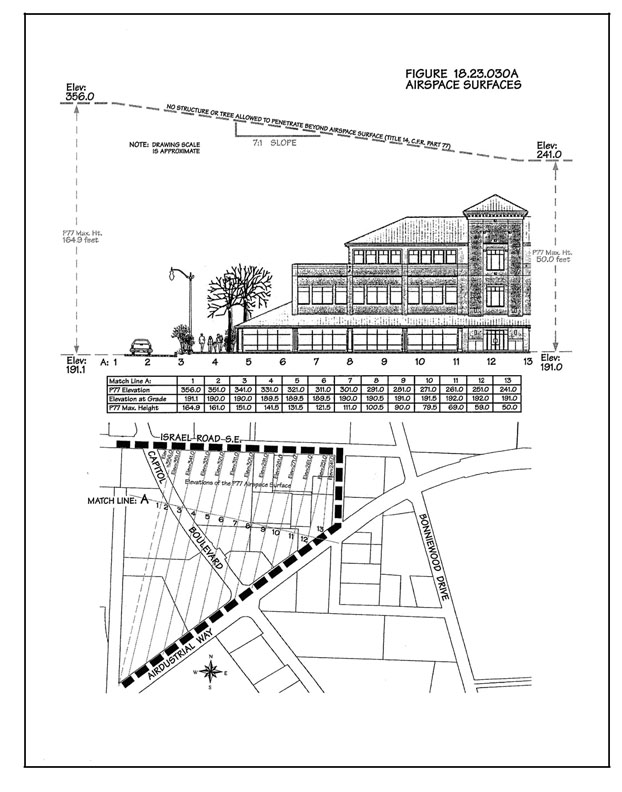
(Ord. O2020-005, Amended, 03/16/2021; Ord. O2011-002, Amended, 03/01/2011; Ord. O2006-034, Amended, 07/17/2007; Ord. O2001-020, Added, 05/07/2002)
18.23.040 Design standards – General.
A. Transparency. For commercial uses, windows shall cover at least fifty percent of the ground floor building wall area facing a public street other than a main street. Ground floor windows must provide visibility into building interiors. Glass must be clear or lightly tinted. These requirements shall apply to that area of the ground floor building wall fronting the street up to the finished ceiling height of the first floor building space. Windowsills shall begin twelve to thirty inches above the finished grade of the first floor building space. See Diagram 18.23.040A.
The community development director may administratively allow the fifty percent minimum transparency requirement to be reduced to thirty percent if:
1. At least four of the following pedestrian features are located between the building and the street: benches, bicycle racks, refuse containers, ornamental lighting, planters, exterior clocks, drinking fountains, public art and water features. The location and type of furnishing(s) shall be determined through the site plan review process. All furnishings shall be of a uniform style and color, and be located so as not to obstruct pedestrian access along sidewalks and to businesses; and
2. Portions of the wall without a ground level window, door or other facade opening along any facade section of twenty feet in length or more shall receive one or more of the design treatments described in subsection B of this section up to at least the finished ceiling height of the first floor building space.
DIAGRAM 18.23.040A
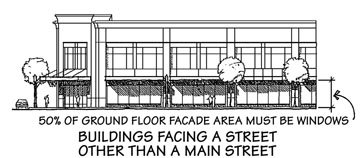
B. Treatment of Blank Walls Perpendicular to a Street. A building or parking structure wall that is perpendicular to and readily visible from a street and is without a ground level window, door or other facade opening along any facade section of twenty feet in length or more is considered a blank wall. A blank wall shall receive one or more of the following design treatments up to at least the finished ceiling height of the first floor building space.
See Diagram 18.23.040B.
1. Install a vertical trellis in front of the wall with climbing vines or other plant materials over at least thirty percent of the blank wall surface. Facade landscaping provided under pedestrian weather structures shall be of such width that a minimum of four feet of unobstructed walking area remains under the building awning, canopy, overhang, or other weather protection structure.
2. Provide a decorative masonry pattern, or other architectural feature as approved by the community development director, over at least thirty percent of the blank wall surface.
3. Employ small setbacks, projections, indentations, or intervals of material change to break up the wall’s surface.
DIAGRAM 18.23.040B
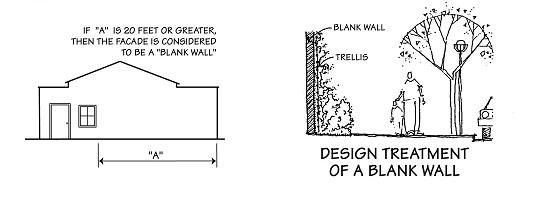
C. Character and Massing. Building and parking structure facades one hundred feet or greater in length that face a street shall incorporate vertical and/or horizontal variations in setback, material or fenestration design along the length of the facade in at least two of the methods listed below. Provided, that buildings and parking structures required to meet the upper floor step back requirement in Diagram 18.23.050C2a need only incorporate one of the additional methods listed below. For a project with more than one building or parking structure containing a facade subject to this requirement, a variation in facade treatments is required to differentiate the appearance of buildings and parking structures. See Diagram 18.23.040C.
1. Vertical Facade Changes. Incorporate intervals of architectural variation at least every eighty feet over the length of the applicable facade, such as:
a. Varying the arrangement, proportioning and/or design of windows and doors;
b. Incorporating changes in architectural materials;
c. Projecting forward or recessing back portions or elements of the applicable facade.
2. Horizontal Facade Changes. Designed to differentiate the ground floor from the upper floors, such as:
a. Stepping back the upper floors from the ground floor building or parking structure facade;
b. Changing materials between the building or parking structure base and upper floors;
c. Including a continuous cornice line or pedestrian weather protection element between the ground floor and upper floors.
DIAGRAM 18.23.040C
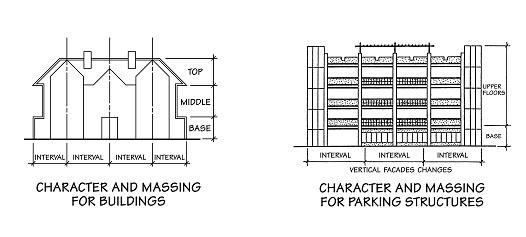
D. Roof Lines. Rooflines must conform to one of the following options to provide a visual terminus to the tops of buildings and parking structures and to soften flat roof designs. See Diagram 18.23.040D.
1. Roof line with architectural focal point. Incorporate a prominent rooftop feature such as a peak, tower, gable, dome, barrel vault or roof line trellis structure.
2. Roof Line Variation. Articulate the roofline through a variation or step in roof height detail, such as:
a. Projected Cornice. Articulate the roofline through a variation or step in cornice height or detail. Cornices must be located at or near the top of the wall or parapet.
b. Articulated Parapet. Roofline parapets shall incorporate angled, curved or stepped detail elements.
3. Pitched Roof or Full Mansard. A roof with angled edges, with or without a defined ridgeline and extended eaves.
4. Terraced Roof. A roofline incorporating setbacks for balconies, roof gardens, or patios.
DIAGRAM 18.23.040D
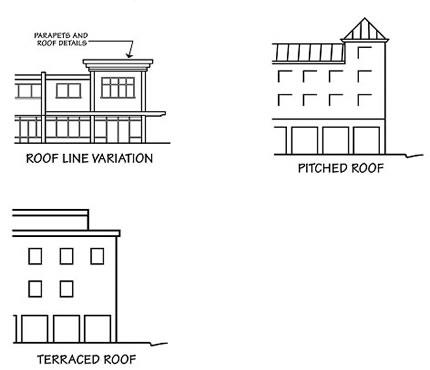
E. Rooftop Equipment. Building and parking structure rooftops shall be designed to effectively screen mechanical equipment from street-level view through one or more of the following methods. See Diagram 18.23.040E.
1. A concealing roof line;
2. A terraced facade;
3. A screening wall or grillwork directly surrounding the equipment;
4. Sufficient setback from the facade edge to be concealed from the ground level view.
DIAGRAM 18.23.040E
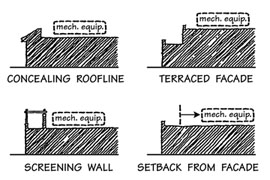
F. Additional Parking Structure Design Standards. The following parking structure design standards shall be in addition to design standards in other sections of this chapter:
1. Parking Decks. Parking decks shall be flat where feasible. At a minimum, a majority of both the ground floor and top parking decks shall be required to be flat, as opposed to continuously ramping. See Diagram 18.23.040F.
2. Elevators and Stairwells. External elevator towers and stairwells shall be open to public view, or enclosed with transparent glazing.
3. Lighting. Lighting on and/or within multilevel parking structures shall be screened, hooded or otherwise limited in illumination area so as to minimize excessive “light throw” to off-site areas. See Diagram 18.23.040F.
4. Top Floor Wall Designs. Parking structure top floor wall designs must conform to at least one of the following options:
a. Top Floor Wall Focal Point. A top floor wall focal point refers to a prominent wall edge feature such as a glazed elevator and/or stair tower, or top floor line trellis structure.
b. Top Floor Wall Line Variation.
i. Projecting Cornice. A top floor wall line is articulated through a prominent cornice or step in height. Cornices must be located at or near the top of the wall or parapet.
ii. Articulated Parapet. Top floor wall line parapets shall incorporate angled, curved or stepped detail elements, articulated patterns or a decorative railing.
c. Top Floor Wall Design of Adjacent Structures. Blend the top floor wall of parking structures with design elements of adjacent buildings.
DIAGRAM 18.23.040F
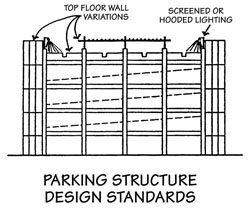
5. Screening of Cars in an Open Parking Structure. The intent of these requirements is to provide screening of cars that are parked in open parking structures in a manner that does not compromise adequate safety and security.
a. Parking areas on the ground floor parking level of an open parking structure shall be screened from the street, pedestrian plazas and pedestrian walkways in at least one of the following ways. Screening methods shall not exceed a height of four feet. See Diagram 18.23.040F5.
i. Five-foot-wide landscape buffer consisting of a mix of evergreen shrubs or trees and groundcover spaced no more than four feet apart.
ii. Decorative trellis work and/or screening as architectural elements on the parking structure facade.
iii. Glass window display cases incorporated into ground floor walls built between two structural pillars. Glass window display cases shall be at least two feet deep and begin a minimum of twelve inches above the ground.
iv. Decorative brick work as architectural elements on the parking structure.
b. Parking areas on levels above the ground floor of an open parking structure shall be screened from the street, pedestrian plazas and walkways in at least one of the following ways. The screening method(s) must reach a minimum height of forty-two inches above the floor. These screening methods supplement the vehicle barrier requirement of the Tumwater Building Code.
i. Decorative railing.
ii. Planters integrated into the parking structure facade design.
iii. Decorative trellis work on the parking structure facade.
DIAGRAM 18.23.040F5
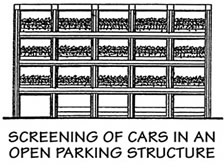
6. Parking Floors Located Under or Within Buildings.
a. Parking located under or within buildings shall subordinate the garage entrance to the pedestrian entrance in terms of prominence on the street, location and design emphasis. See Diagram 18.23.040F6.
b. Parking at grade under a building facing a street, pedestrian plaza or pedestrian walkway shall be either completely enclosed within the building, except for entrances, exits and windows, or screened in accordance with subsection (F)(5)(a) of this section.
DIAGRAM 18.23.040F6
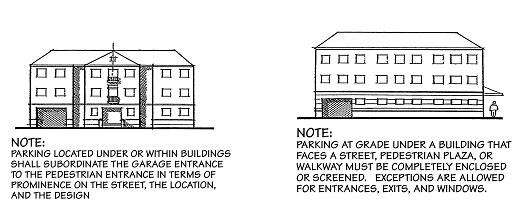
G. Site Design.
1. Service Areas. Service areas, including loading docks, dumpsters, mechanical equipment and utility vaults shall be located away from pedestrian areas and screened with built and/or landscaped confinements.
2. Pedestrian Plazas/Courtyards. A pedestrian plaza/courtyard (hereinafter plaza) must be designed to encourage pedestrian use and activity, and to serve as a link between a development and the public right-of-way. Plazas must meet the following standards. See Diagram 18.23.040G.
a. The plaza shall consist of one contiguous space, with at least one edge abutting a public right-of-way.
b. A plaza shall be a minimum of four hundred square feet with a minimum depth of ten feet, measured from the abutting street right-of-way.
c. A plaza shall have an articulated edge created by buildings, benches or landscaping to provide visual interest and additional seating where people may linger out of the pedestrian traffic flow.
d. A plaza must be integrated into the streetscape and be visually and physically accessible from the public right-of-way. The plaza shall be distinguished from the public right-of-way by landscaping and a change in paving material. Paving is required and shall consist of unit pavers or concrete with special textures, patterns and/or decorative features.
e. Pedestrian weather protection shall be provided. Examples include awnings, canopies and marquees. A minimum of eighty-five percent of the plaza shall be uncovered and open to the sky, excluding tree canopies.
f. Pedestrian amenities shall be provided. Examples of amenities include seating, landscaping, drinking fountains, art work, bicycle racks, sculptures and water features.
g. Lighting in plazas is required. Lighting height shall not exceed fifteen feet. The lighting plan shall include pedestrian-oriented lights, such as globes and light bollards.
h. Plazas shall be held in a single ownership where such ownership assumes full responsibility for maintenance and operation, or held in common ownership by all of the owners in the development area through an owners’ association or similar organization. The city and the property owner(s) shall enter into an operational agreement to coordinate the use, activities, events and maintenance of the plaza. A pedestrian access easement must be granted to allow public access to the plaza. All such public access easements shall be described and shown on final site plans and binding site plans.
The city as a condition of approval may choose to accept dedication, maintenance and responsibility for the area, when the area to be dedicated is one or more of the following.
i. Adjacent to an established or future city park.
ii. Includes access to a wetland, important fish/wildlife habitat, or other environmentally sensitive area.
iii. If the city determines it is in the public interest to accept public dedication.
DIAGRAM 18.23.040G
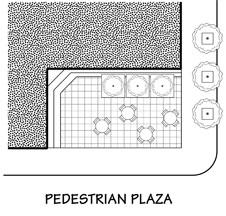
(Ord. O2011-002, Amended, 03/01/2011; Ord. O2006-034, Amended, 07/17/2007; Ord. O2001-020, Added, 05/07/2002)
18.23.050 Development and design standards – Specific to properties fronting main streets.
The following requirements apply to development proposals on land within the town center mixed use subdistrict that has frontage on rights-of-way designated as main streets in Figure 18.23.010. These requirements supplement requirements described in other sections of this chapter.
A. Maximum Setback.
1. Intent. Enclose and define the street space. Place building walls that will:
a. Provide human-scaled street enclosure and building edge continuity on key town center streets.
b. Contribute to a continuous building edge on lots adjacent to designated main streets.
c. Provide a pedestrian-friendly environment by making physical and visual contact between interior building activities and the street.
2. Requirement.
a. The maximum setback shall be zero feet from the abutting main street right-of-way. Where a lot has frontage on more than one main street, the maximum setback shall apply only to New Market Street; provided, that first floor uses required by subsection E of this section that front any main street shall be zero feet from the abutting main street right-of-way.
b. Exceptions. Exceptions may be granted to allow setbacks of existing buildings to be maintained, and to integrate publicly accessible site design elements in new developments that encourage pedestrian use and activity along the street. Such site design elements may include but not be limited to the following:
i. Building modulation.
ii. Pedestrian plazas or courtyards.
iii. Covered or recessed building entryways.
iv. Commercial uses and/or displays, such as vendors, newsstands and cafes.
v. Public art, such as water features and sculptures.
vi. Seating and/or planting areas.
vii. Pedestrian-oriented signs.
B. Primary Building Entrance.
1. Intent. Generate pedestrian and street activity. Create a prominent entry that conveys a clear sense of arrival and that uses high quality products that contribute to the richness and detail of the facade.
2. Requirements.
a. Primary building entrance(s) must face the main street. Where a lot is adjacent to more than one main street, primary building entrances shall face New Market Street.
b. Primary building entrances must be clearly visible from the sidewalk in front of the building.
c. Direct access shall be provided from either the sidewalk if the building facade is directly adjacent to the sidewalk, from a pedestrian plaza, or both. A pedestrian plaza must be integrated into the streetscape and be visually and physically accessible from the public rights-of-way.
C. Building Design.
1. Intent. Design buildings and parking structures to promote an architecturally appealing environment. Design emphasis should be given to the pedestrian through the provision of structural and facade elements that encourage pedestrian activity.
2. Requirements.
a. Upper Floor Step Back (Diagram 18.23.050C2a). Buildings and parking structures that face a main street must step back all floors above the second floor a minimum of ten feet (for example, a four-story building would have the two floors abutting the sidewalk, and all floors above the second floor would be stepped back a minimum of ten feet from the sidewalk). This requirement shall not apply to the following with the approval of the community development director:
i. Portions of a building or parking structure that abut a publicly accessible pedestrian plaza or courtyard located between the building or parking structure and the front yard property line.
ii. Building design features, such as pedestrian entryways; provided the feature does not cover more than fifteen percent of the total building facade facing a main street.
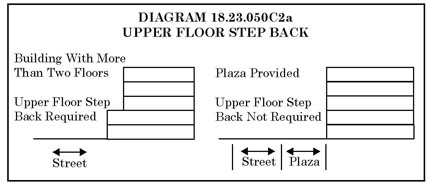
b. Transparency. Windows shall cover at least sixty percent of the first floor building wall area facing a main street for commercial uses. First floor windows must provide visibility into building interiors. Glass must be clear or lightly tinted. These requirements shall apply to that area of the first floor building wall fronting the street up to the finished ceiling height of the first floor building space. Windowsills shall begin twelve to thirty inches above the finished grade of the first floor building space. See Diagram 18.23.050C2b.
DIAGRAM 18.23.050C2b
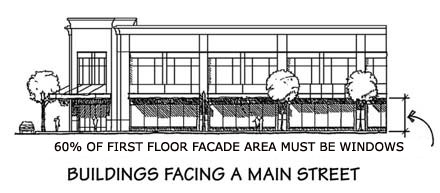
c. Pedestrian Weather Protection. Building facades with first floor commercial uses facing a main street shall be designed to provide for pedestrian weather protection through the use of awnings, canopies, marquees, arcades or building overhangs. Pedestrian weather protection structures shall extend along at least the length of the main street facing facade with a first floor commercial use.
i. Pedestrian weather protection structures shall extend a minimum of four feet out from the building facade. Awnings, canopies, marquees and building overhangs may project into the public right-of-way, subject to the projection requirements of the Tumwater building code. Projections into the public right-of-way must be approved by the community development director, public works director and the building official. Arcades must be on private property. Pedestrian weather protection structures shall be architecturally integrated with the ground level design of the building to which they are attached. See Diagram 18.23.050C2c.
ii. The minimum height of the pedestrian weather protection structures shall be ten feet above the sidewalk surface. Maintain a horizontal consistency by aligning the bottom edge of weather protection structures with those on adjacent buildings; provided, that the bottom edge of such structures shall be at least ten feet above the sidewalk surface. See TMC 18.44.150(C) for suspending signs beneath weather-protection structures.
DIAGRAM 18.23.050C2c
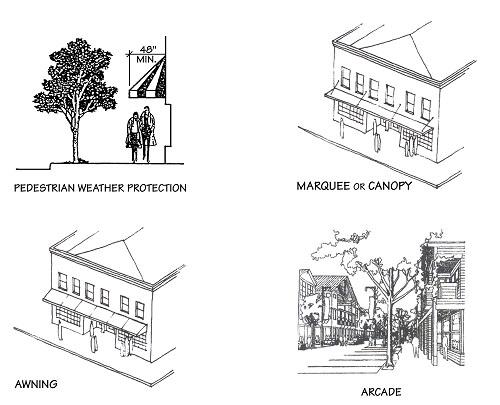
D. Surface Parking Lots.
1. Intent. Discourage the disruption of the continuous building edge along the street. Minimize potential interaction between pedestrians and vehicles.
2. Requirements. Surface parking lots are not allowed to abut New Market Street. Surface parking shall be located behind buildings but may be allowed to abut 73rd and 71st Avenues with landscaping buffers and/or visual screening. One curb cut for access to parking lots is allowed on each side of the portion of New Market Street designated MS4 in the Tumwater town center street design plan. Access to parking lots from other portions of New Market Street is prohibited unless no other alternative is feasible.
E. First Floor Uses in Commercial and Residential Developments.
1. Intent. Create a pedestrian environment with first floor land uses that generate pedestrian activity which complement the wide sidewalks, street trees, pedestrian-level street lights, street furniture and mid-block crossings that characterize the pedestrian-oriented streetscape.
2. Requirement. For commercial and residential developments, a minimum of twenty percent of the gross floor area on the first floor shall be dedicated to one or more of the following: retail sales, restaurants, personal services, professional services, medical clinics, child day care centers, child mini-day care centers, museums, or art galleries. These uses may be located within mixed use structures or in separate structures within the development. For example, a professional office building may incorporate a restaurant on the first floor, or a building dedicated entirely to professional offices may be constructed adjacent to a single-use restaurant building within the same development.
First floor uses required by this section must be externally oriented. “Externally oriented” for the purpose of this regulation shall mean having a public entrance opening directly to the outside and facing the main street. A minimum finished ceiling height of ten feet is required.
(Ord. O2023-012, Amended, 02/06/2024; Ord. O2011-002, Amended, 03/01/2011; Ord. O2006-034, Amended, 07/17/2007; Ord. O2001-020, Added, 05/07/2002)
18.23.060 Park and open space.
A. New development in the TC zone district shall set aside land for park and open space area as specified in TMC 17.12.210 and 18.42.130 and the citywide design guidelines.
B. The pedestrian plazas and courtyard requirements of TMC 18.23.040(G)(2) shall be adhered to and those requirements shall take precedence over the other requirements listed in this section.
(Ord. O2020-015, Added, 02/16/2021)17


